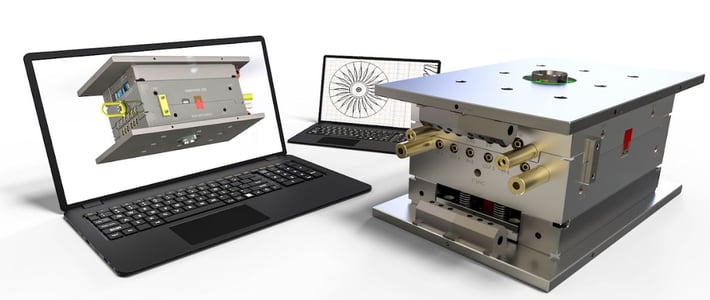
Draft angle is a critical concept in plastic injection molding. It directly affects both the quality and manufacturability of plastic parts, so it’s crucial to get it right from the start to avoid production issues down the line. Worse, it can be a detail that can render your injection mold useless.
Put simply, draft angle refers to the taper or angle that is designed into the vertical walls of a plastic part, relative to the vertical axis of the mold. Properly tapered walls ensure that the finished part can more easily eject from the mold after the forming process is complete. Essentially, an optimal draft angle is necessary because it prevents the part from getting stuck in the mold cavity due to the friction between the plastic material and the mold surfaces on the texture side and the suction between the plastic material and the mold surfaces on the interior side.
Backed by more than three decades of innovation in plastic injection molding services, at AIM Processing we know exactly what it takes to ensure the highest quality molded products possible. Draft angle is just one of the many elements we consider in the design, development, and setup phases. Below, we go over some of the most important considerations for draft angles and how they affect the finished quality of your products.
Key Considerations for Draft Angles in the Injection Molding Process:
As mentioned, the main purpose of a draft angle is to facilitate the removal of the molded part from the mold without damaging the part. Without a proper draft angle, the part may tend to bind to the mold surfaces. Additionally, ejecting the part from the moving side of the tool creates a suction or vacuum that increases throughout the ejection stroke until air can fill the void. Generally this results in damage and distortion, as well as a much less consistent surface finish. At the very least, you’ll wind up with increased inconsistency in your overall product quality.
Angle Measurement
Draft angles are typically measured in degrees relative to the vertical axis of the mold. A common draft angle for custom plastic injection molded parts typically ranges between 1 to 3 degrees, but this can vary depending on the material, part geometry, and specific requirements of the application.
A larger draft angle makes it easier to eject the part, especially when using deeper molds. However, the typical side effect is a different dimension at the top of the part vs. the bottom – so manufacturers and product designers must choose their draft angles wisely to ensure the dimensional requirements are satisfied.
Part Design Considerations
When designing plastic parts for injection molding, we incorporate the appropriate draft angles into the part geometry. This is especially important for complex geometric features like sidewalls, ribs, and bosses. It's essential to first determine the correct draft angles for your specific application (in consideration of material choice and product complexity) before beginning the injection molding process.
Mold Design
The mold itself must also be designed with features that accommodate a proper draft angle. Both the core (the part of the mold that forms the internal surfaces of the part) and the cavity (the part of the mold that forms the external surfaces of the part) should incorporate draft angles to ensure proper ejection.
Material Selection
The choice of plastic material can have a big impact on the required draft angle. Different materials have varying coefficients of friction, which affects the ease of ejection. Some materials may require a larger draft angle to ensure smooth ejection.
The Impact of Draft Angle on Finished Product Quality:
Part Surface Finish
The surface finish of the mold and the part can also affect ejection. A polished or textured mold surface can impact the friction between the part and the mold. It's important to consider the surface finish in conjunction with the draft angle. If the cosmetic side draft is not generous enough, the texture will drag & scuff.
Pin Push and Warping
If the interior surface draft is insufficient, the vacuum/suction forces will grow and the ejector pins will struggle to eject. These pins may slightly push through the part. Additionally, high suction forces may warp the part.
Impact on Part Geometry
It's crucial to be mindful of how the draft angle affects the final dimensions and appearance of the part. A significant draft angle can alter the shape and size of features on the part, which may require adjustments in the part design.
One of America’s Leading Plastic Injection Molding Specialists
Based in the Denver, Colorado region since 1993, AIM Processing is proud to be one of the nation’s leading injection molding companies specializing in precision-built plastic products. From choosing the optimum draft angle to ensuring superior finished quality, we have your custom plastic molding project covered from start to finish.

 SINCE 1993 MADE IN USA
SINCE 1993 MADE IN USA 


